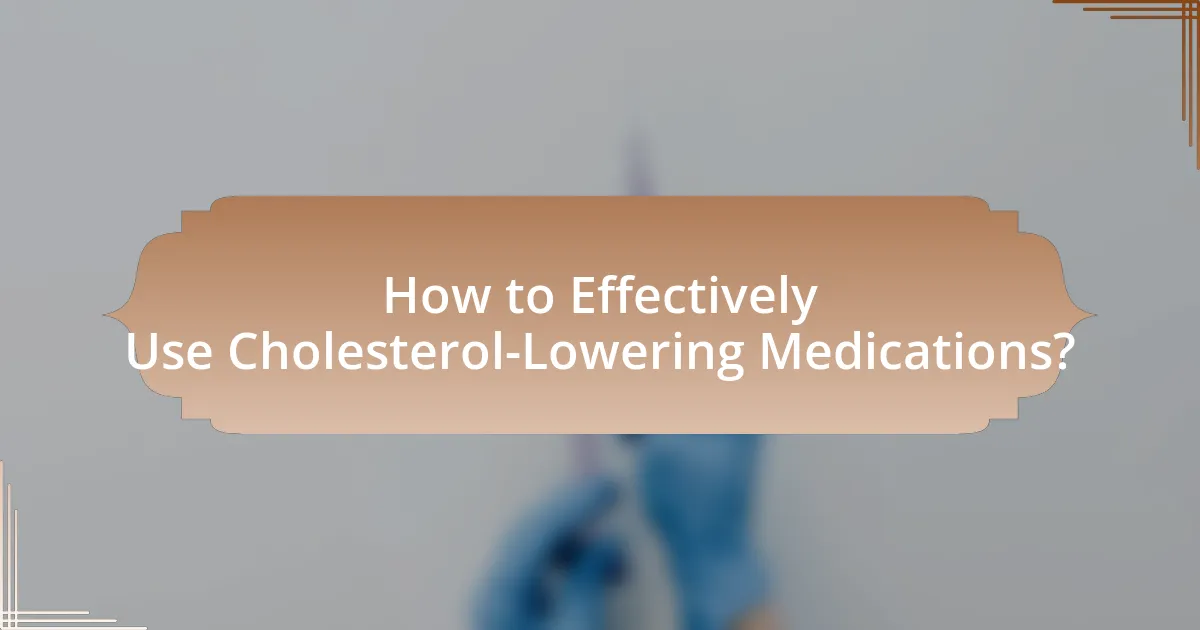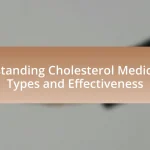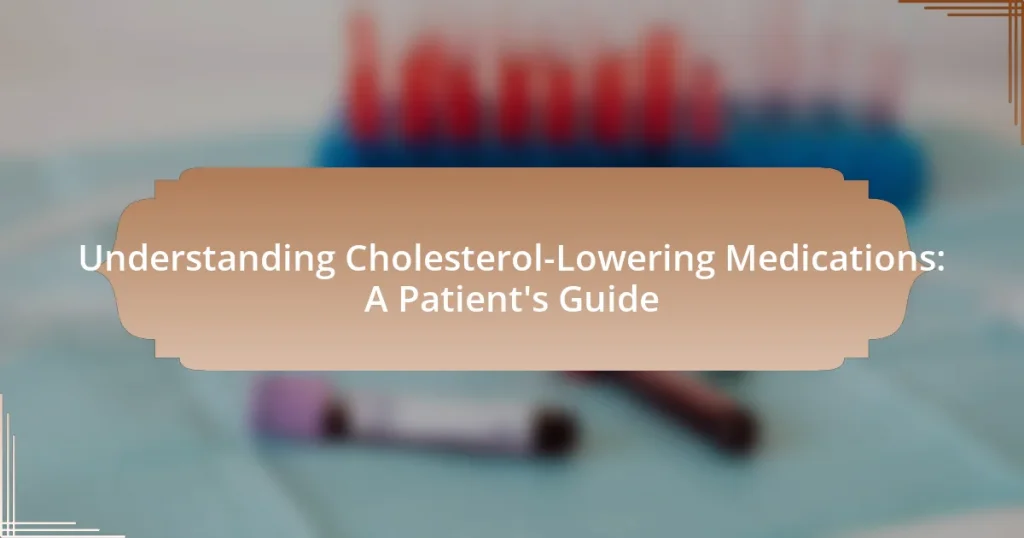Cholesterol-lowering medications are essential drugs aimed at reducing low-density lipoprotein (LDL) cholesterol levels in the bloodstream, thereby decreasing the risk of cardiovascular diseases such as heart attacks and strokes. This article provides a comprehensive overview of various types of cholesterol-lowering medications, including statins, bile acid sequestrants, niacin, fibrates, and PCSK9 inhibitors, detailing their mechanisms of action, benefits, and potential side effects. It also discusses who should consider these medications, how to effectively use them, and the importance of lifestyle changes and regular monitoring to enhance their efficacy. Understanding these aspects is crucial for patients seeking to manage their cholesterol levels and improve their overall heart health.

What are Cholesterol-Lowering Medications?
Cholesterol-lowering medications are drugs designed to reduce levels of cholesterol in the bloodstream, primarily low-density lipoprotein (LDL) cholesterol, which is linked to an increased risk of cardiovascular diseases. These medications include statins, bile acid sequestrants, niacin, and fibrates, each working through different mechanisms to lower cholesterol levels. Statins, for example, inhibit the enzyme HMG-CoA reductase, which plays a central role in cholesterol production in the liver, leading to a significant decrease in LDL cholesterol levels. Clinical studies have shown that statins can reduce the risk of heart attacks and strokes by up to 30% in high-risk populations, validating their effectiveness as cholesterol-lowering agents.
How do Cholesterol-Lowering Medications work?
Cholesterol-lowering medications primarily work by reducing the levels of low-density lipoprotein (LDL) cholesterol in the bloodstream. Statins, the most commonly prescribed class of these medications, inhibit the enzyme HMG-CoA reductase, which plays a crucial role in cholesterol synthesis in the liver. This reduction in cholesterol production leads to an increase in the uptake of LDL cholesterol from the blood into the liver, thereby lowering overall blood cholesterol levels. Clinical studies have shown that statins can reduce LDL cholesterol levels by 20% to 60%, significantly decreasing the risk of cardiovascular events such as heart attacks and strokes.
What are the different types of Cholesterol-Lowering Medications?
The different types of cholesterol-lowering medications include statins, bile acid sequestrants, niacin, fibrates, and PCSK9 inhibitors. Statins, such as atorvastatin and simvastatin, work by inhibiting the enzyme HMG-CoA reductase, which plays a central role in cholesterol production in the liver. Bile acid sequestrants, like cholestyramine, bind bile acids in the intestine, leading to increased cholesterol conversion to bile acids. Niacin, also known as vitamin B3, reduces the liver’s production of VLDL and LDL cholesterol. Fibrates, such as fenofibrate, primarily lower triglyceride levels and can modestly increase HDL cholesterol. PCSK9 inhibitors, like alirocumab, are monoclonal antibodies that enhance the liver’s ability to remove LDL cholesterol from the blood. These medications have been shown to effectively lower cholesterol levels and reduce the risk of cardiovascular events.
How do these medications affect cholesterol levels in the body?
Cholesterol-lowering medications primarily reduce levels of low-density lipoprotein (LDL) cholesterol in the body. Statins, a common class of these medications, inhibit the enzyme HMG-CoA reductase, which plays a crucial role in cholesterol synthesis in the liver, leading to decreased LDL levels. Research indicates that statins can lower LDL cholesterol by 20% to 60%, depending on the specific drug and dosage. Other medications, such as bile acid sequestrants, work by binding bile acids in the intestine, prompting the liver to use more cholesterol to produce new bile acids, thereby lowering cholesterol levels. Additionally, ezetimibe reduces cholesterol absorption in the intestines, further contributing to lower LDL levels. These mechanisms collectively demonstrate how cholesterol-lowering medications effectively manage cholesterol levels in the body.
What are the common uses of Cholesterol-Lowering Medications?
Cholesterol-lowering medications are commonly used to reduce levels of low-density lipoprotein (LDL) cholesterol and triglycerides in the blood. These medications, such as statins, are primarily prescribed to prevent cardiovascular diseases, including heart attacks and strokes, by lowering the risk associated with high cholesterol levels. Statins have been shown to decrease LDL cholesterol by 20% to 60%, significantly reducing the incidence of major cardiovascular events, as evidenced by studies like the JUPITER trial, which demonstrated a 44% reduction in heart attack risk among patients with elevated C-reactive protein levels. Additionally, cholesterol-lowering medications are utilized in patients with familial hypercholesterolemia, a genetic condition leading to extremely high cholesterol levels, to manage their condition effectively.
Who should consider taking Cholesterol-Lowering Medications?
Individuals who should consider taking cholesterol-lowering medications include those with a history of cardiovascular disease, high LDL cholesterol levels, or diabetes. According to the American College of Cardiology and the American Heart Association, patients with atherosclerotic cardiovascular disease (ASCVD) are recommended to initiate statin therapy to reduce the risk of heart attacks and strokes. Additionally, adults aged 40 to 75 with diabetes and an LDL cholesterol level of 70-189 mg/dL should also consider these medications to manage their cholesterol levels effectively. Furthermore, individuals with an LDL cholesterol level of 190 mg/dL or higher are advised to start treatment regardless of other risk factors.
What conditions do these medications help manage?
Cholesterol-lowering medications help manage conditions such as hyperlipidemia, cardiovascular disease, and atherosclerosis. These medications, including statins and fibrates, are specifically designed to reduce elevated cholesterol levels, which are significant risk factors for heart attacks and strokes. Clinical studies have demonstrated that lowering LDL cholesterol can decrease the incidence of cardiovascular events, thereby validating the effectiveness of these medications in managing these health conditions.

What are the Benefits and Risks of Cholesterol-Lowering Medications?
Cholesterol-lowering medications, primarily statins, offer significant benefits and risks. The primary benefit is the reduction of low-density lipoprotein (LDL) cholesterol, which lowers the risk of cardiovascular diseases, including heart attacks and strokes; studies indicate that statins can reduce the risk of major cardiovascular events by approximately 25-30%. However, risks associated with these medications include potential side effects such as muscle pain, liver damage, and an increased risk of diabetes; research shows that about 10% of patients may experience muscle-related side effects. Therefore, while cholesterol-lowering medications can effectively reduce cardiovascular risk, they also carry potential adverse effects that must be considered.
What benefits can patients expect from Cholesterol-Lowering Medications?
Patients can expect several benefits from cholesterol-lowering medications, primarily a significant reduction in low-density lipoprotein (LDL) cholesterol levels. Lowering LDL cholesterol is associated with a decreased risk of cardiovascular events, such as heart attacks and strokes. Clinical studies, including the Cholesterol Treatment Trialists’ Collaboration, have shown that for every 1 mmol/L reduction in LDL cholesterol, there is an approximate 20-25% reduction in the risk of major vascular events. Additionally, these medications can improve overall heart health and may lead to better management of existing cardiovascular conditions.
How do these medications reduce the risk of heart disease?
Cholesterol-lowering medications, such as statins, reduce the risk of heart disease by lowering levels of low-density lipoprotein (LDL) cholesterol in the bloodstream. Elevated LDL cholesterol is a significant risk factor for atherosclerosis, which can lead to heart attacks and strokes. Statins work by inhibiting the enzyme HMG-CoA reductase, which plays a central role in cholesterol production in the liver, thereby decreasing overall cholesterol levels. Clinical studies, such as the Scandinavian Simvastatin Survival Study, have shown that statin therapy can reduce the incidence of major cardiovascular events by approximately 30% to 40% in high-risk populations.
What improvements in health markers can be observed?
Improvements in health markers associated with cholesterol-lowering medications include reduced LDL cholesterol levels, increased HDL cholesterol levels, and lower triglyceride levels. Clinical studies have shown that statins, for example, can lower LDL cholesterol by 20-60%, significantly decreasing the risk of cardiovascular events. Additionally, these medications can improve overall lipid profiles, leading to better heart health outcomes.
What are the potential side effects of Cholesterol-Lowering Medications?
Cholesterol-lowering medications, particularly statins, can cause several potential side effects. Common side effects include muscle pain, liver damage, digestive problems, and increased blood sugar levels. Statins, for instance, have been associated with myopathy and rhabdomyolysis, which are serious muscle-related conditions. According to a study published in the Journal of the American College of Cardiology, approximately 10% of patients experience muscle-related side effects when taking statins. Additionally, liver enzyme elevations can occur, necessitating regular monitoring of liver function. Gastrointestinal issues such as nausea and diarrhea are also reported. Furthermore, some studies indicate that statins may increase the risk of developing type 2 diabetes, with a meta-analysis in the Lancet showing a 9% increased risk among statin users.
What are the most common side effects experienced by patients?
The most common side effects experienced by patients taking cholesterol-lowering medications include muscle pain, gastrointestinal issues, and liver enzyme abnormalities. Muscle pain, often referred to as myopathy, affects approximately 5-10% of patients on statins, which are a common class of cholesterol-lowering drugs. Gastrointestinal issues such as nausea, diarrhea, and constipation are also prevalent, occurring in about 10-20% of users. Additionally, liver enzyme abnormalities can be detected in 1-3% of patients, necessitating regular monitoring of liver function during treatment. These statistics highlight the frequency and types of side effects associated with cholesterol-lowering medications.
How can patients manage or mitigate these side effects?
Patients can manage or mitigate the side effects of cholesterol-lowering medications by adhering to a few key strategies. First, they should communicate openly with their healthcare provider about any side effects experienced, as adjustments to dosage or medication type may alleviate discomfort. Additionally, incorporating lifestyle changes such as a balanced diet rich in fruits, vegetables, and whole grains can enhance the effectiveness of the medication while reducing side effects. Regular physical activity is also beneficial, as it can improve overall cardiovascular health and potentially lessen medication-related issues.
Research indicates that patients who engage in lifestyle modifications alongside medication adherence report fewer side effects and improved health outcomes. For instance, a study published in the Journal of the American College of Cardiology found that lifestyle interventions significantly reduced the incidence of muscle-related side effects in patients taking statins. Therefore, proactive communication with healthcare providers and commitment to healthy lifestyle choices are essential for managing side effects effectively.

How to Effectively Use Cholesterol-Lowering Medications?
To effectively use cholesterol-lowering medications, patients should adhere to their prescribed dosage and schedule as directed by their healthcare provider. Consistent use maximizes the medication’s efficacy in reducing LDL cholesterol levels, which is crucial for cardiovascular health. Studies indicate that adherence to statin therapy can lower the risk of heart attacks by up to 30% in high-risk individuals. Additionally, patients should regularly monitor their cholesterol levels and maintain open communication with their healthcare provider to assess the medication’s effectiveness and make necessary adjustments.
What should patients know before starting Cholesterol-Lowering Medications?
Patients should know that cholesterol-lowering medications, such as statins, can effectively reduce LDL cholesterol levels and lower the risk of cardiovascular events. Before starting these medications, patients should be aware of potential side effects, including muscle pain, liver enzyme changes, and gastrointestinal issues, which occur in a small percentage of users. Additionally, patients should discuss their complete medical history and any other medications they are taking with their healthcare provider to avoid interactions. Regular monitoring of cholesterol levels and liver function tests may be necessary to assess the effectiveness and safety of the treatment.
How should these medications be taken for maximum effectiveness?
Cholesterol-lowering medications should be taken as prescribed by a healthcare provider to achieve maximum effectiveness. This typically involves taking the medication at the same time each day, with or without food, depending on the specific medication’s instructions. For instance, statins are often recommended to be taken in the evening, as cholesterol production in the liver is higher at night. Adhering to the prescribed dosage and schedule is crucial, as studies show that consistent use can significantly lower LDL cholesterol levels and reduce cardiovascular risk.
What lifestyle changes should accompany medication use?
Lifestyle changes that should accompany medication use include adopting a heart-healthy diet, engaging in regular physical activity, maintaining a healthy weight, and avoiding tobacco use. A heart-healthy diet emphasizes fruits, vegetables, whole grains, lean proteins, and healthy fats, which can help lower cholesterol levels. Regular physical activity, such as at least 150 minutes of moderate exercise per week, contributes to improved cardiovascular health and can enhance the effectiveness of cholesterol-lowering medications. Maintaining a healthy weight reduces the risk of heart disease and can further support medication efficacy. Additionally, avoiding tobacco use is crucial, as smoking can exacerbate cholesterol-related issues and overall cardiovascular health. These lifestyle modifications are supported by research indicating that they can significantly improve outcomes for individuals on cholesterol-lowering medications.
What are the best practices for monitoring cholesterol levels while on medication?
The best practices for monitoring cholesterol levels while on medication include regular blood tests, maintaining a healthy lifestyle, and adhering to prescribed medication regimens. Regular blood tests, typically every 3 to 12 months, help assess the effectiveness of the medication and ensure cholesterol levels are within target ranges. Maintaining a healthy lifestyle, which includes a balanced diet low in saturated fats and regular physical activity, supports medication efficacy. Adhering to prescribed medication regimens is crucial, as consistent use maximizes the potential benefits of cholesterol-lowering drugs. These practices are supported by guidelines from organizations such as the American Heart Association, which emphasizes the importance of regular monitoring and lifestyle modifications in managing cholesterol levels effectively.
How often should patients have their cholesterol levels checked?
Patients should have their cholesterol levels checked at least once every four to six years if they are at low risk for heart disease. For those with higher risk factors, such as a history of heart disease, diabetes, or high cholesterol, more frequent testing may be necessary, typically once a year. The American Heart Association recommends these guidelines to monitor cardiovascular health effectively and adjust treatment plans as needed.
What signs should patients look for that indicate medication effectiveness or issues?
Patients should look for improvements in cholesterol levels and a reduction in cardiovascular symptoms to indicate medication effectiveness. Effective cholesterol-lowering medications typically lead to a decrease in LDL cholesterol and an increase in HDL cholesterol, which can be confirmed through regular blood tests. Additionally, patients may notice fewer symptoms such as chest pain or shortness of breath, indicating improved heart health. Conversely, signs of medication issues include persistent side effects like muscle pain, liver enzyme elevation, or gastrointestinal disturbances, which should prompt consultation with a healthcare provider. Monitoring these signs is crucial for assessing both the effectiveness and safety of cholesterol-lowering treatments.
What tips can help patients adhere to their Cholesterol-Lowering Medication regimen?
To help patients adhere to their cholesterol-lowering medication regimen, it is essential to establish a consistent routine for taking medications. Patients should take their medications at the same time each day, which can enhance memory and reduce the likelihood of missed doses. Additionally, utilizing pill organizers or reminders through smartphone apps can further support adherence by providing visual cues and alerts.
Research indicates that adherence rates improve significantly when patients are educated about the importance of their medication in managing cholesterol levels and reducing cardiovascular risks. For instance, a study published in the Journal of Clinical Lipidology found that patients who received comprehensive education about their medications were 30% more likely to adhere to their regimen compared to those who did not receive such education.
Furthermore, involving family members or caregivers in the medication management process can provide additional support and accountability, which is crucial for maintaining adherence.










